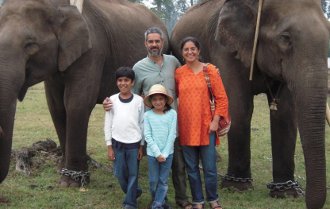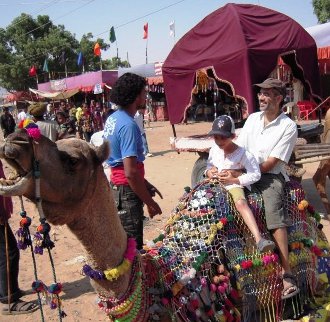|
 Amitabh Bose is professor of mathematical sciences at the New Jersey
Institute of Technology in Newark. He was a 2009-10 Fulbright-Nehru
Scholar affiliated with the School of Physical Sciences at Jawaharlal
Nehru University in New Delhi where he completed mathematical modeling
of the dynamics of neuronal networks.
Amitabh Bose is professor of mathematical sciences at the New Jersey
Institute of Technology in Newark. He was a 2009-10 Fulbright-Nehru
Scholar affiliated with the School of Physical Sciences at Jawaharlal
Nehru University in New Delhi where he completed mathematical modeling
of the dynamics of neuronal networks.
"Aap kahain se hai?" (Where are you from?) was a question that
cropped up over and over as my wife Tudy, son Avinash, daughter Simrun
and I traveled throughout India. The answer, however, was not so
straightforward. Both Tudy and I are of Indian origin, but each of our
sets of parents moved to the US between 40 and 50 years ago. Upon
telling this to people, the standard response was, "Indian tho hain, na?" (But you are Indian, right?) Well, you get the idea; the need to establish connections is part of what makes us human.
When I learned that the Fulbright program was giving me the chance to
spend a year in India I was thrilled! It provided me with an
opportunity to build new research collaborations with scientists in
India. It gave my family a chance to experience living life in the
country of our parents’ origin. Finally, and quite importantly, it
allowed us to share with the local population some insights about life
in America, especially for those of us who are first generation
Americans.
My research in India focused on how mathematics is used to
describe electrical activity in the brain. I started two collaborative
projects with scientists at my affiliating university during my
research. The first investigated how the structure of randomly
connected neuronal networks affects their ability to produce periodic
electrical activity; and the second studied mechanisms for the onset
and offset of rapid eye movement sleep. I also developed and taught a
graduate course on computational neuroscience. Apart from this, I was
invited for talks and lectures throughout India. One of the highlights
was the five days I lectured on non-linear dynamics at the SERC School,
Department of Physics, Delhi University. The audience consisted of
bright and eager graduate students from across India who had been
chosen to attend this school. Personally, this experience was
emotionally relevant as both my parents had graduated from this very
department in the late 1950's. I taught in the same lecture hall where
my parents had sat as students 50 years prior!
My Fulbright year in India proved to be beneficial for my
entire family. While I was busy with my research, my wife became
involved with developing educational programs at the Nehru Memorial
Museum and Library at Teen Murti Bhavan in New Delhi. In the US, she is
a middle and high school teacher, so this opportunity allowed her to
remain close to her field. Our children, Avinash and Simrun, loved
attending the American Embassy School. Getting a chance to attend an
international school, they thrived in this international setting,
interacting with kids from all over the world and learning Hindi along
with other subjects. They also soaked in everything they could from
their surroundings, becoming experts on Delhi roads and instructing us
on the best ways to navigate the city! This was a year of learning and
growth for our entire family.
Taking
full advantage of the luxury of time, we traveled extensively over the
course of the year. Places we visited included Pushkar in Rajasthan for
the camel fair, Hampi in Karnataka to see the ruins of Vijaynagar,
Udaipur in Rajasthan for the Fulbright conference, Pelling in Sikkim to
see Mount Kanchenjunga and Bodh Gaya in Bihar where the Buddha achieved
enlightenment. These special places allowed us to experience the
diversity of Indian culture as well as share our stories of life in
America. A particularly fond memory of mine is seeing the Theyyam dance
ritual while at Kannur in Kerala. Having adorned himself elaborately to
take on the persona of a particular god, the dancer put himself into a
trance. After the performance each audience member had a chance to
directly converse with the dancer. What struck me as I watched these
discussions was the sincerity and depth of interaction between dancer
and audience. It gradually became clear that each viewer believed that
they were having a direct conversation with the deity personified by
the dancer. Interestingly, while some left the conversation with a
smile, others left brooding over what they had been told. This was one
of countless experiences, during which our notions were challenged and
our horizons broadened.
Sadly, the year in India came to a close. As we boarded the plane to go
back to the US, we looked back fondly on our time in India. Being under
the auspices of the Fulbright program had added valuably to our stay.
Interacting with the USIEF staff, professors and students at my
affiliating university, people in our neighborhood in Delhi and many
more while traveling in India was very rewarding. I thank the Fulbright
program for making this a truly special year for my family and me.
|
 Amitabh and his son at the Pushkar camel fair in Rajasthan
Amitabh and his son at the Pushkar camel fair in Rajasthan
|
|
